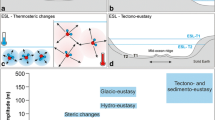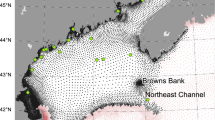Abstract
Geological evidence and oxygen-isotope variations in deep-sea cores provide valuable information about the sea-level variations of the past. Ice-volume equivalent is usually computed by using a constant oceanic area. In this paper a relationship is developed between the continental ice-volume variation and the sea-level drop by taking into account the sea-floor topography and, therefore, the variation of the oceanic area. It appears from such calculations that the last glacial maximum ice volume is 7% less than previously estimated, and that the minimal reconstruction of the ice sheets from Hughes et al. (1981) seems the most likely.
Similar content being viewed by others
References
Andrews JT, Fulton RJ (1987) Inception, growth and decay of the Laurentide Ice Sheet. Episodes 10:13–15
Berger A, Gallée H, Fichefet Th, Marsiat I, Tricot Ch (1988) Testing the astronomical theory with a physical coupled climate-ice sheets model. Scientific Report 1988/3, Université Catholique de Louvain, Institut d'Astronomie et de Géophysique G. Lemaître, Belgium, 21 pp
Chappell J, Shackleton NJ (1986) Oxygen isotopes and sea level. Nature 324:137–140
CLIMAP Project Members (1981) Seasonal reconstructions of the earth's surface at the last glacial maximum. Geological Society of America, Map and Chart Series MC-36, McIntyre A and Cline R (eds), Boulder, col., 1–18
Duplessy JCI, Labeyrie L, Blanc PL (1988) Norwegian sea deep water variations over the last climatic cycle: paleooceanographical implications. In: Wanner H and Siegenthaler U (eds) Long and short term variability of climate. Earth Science Series. Springer Verlag, Berlin Heidelberg New York Tokyo, pp 83–116
Hansen J, Lebedeff S (1988) Global surface air temperatures: update through 1987. Geophys Res Letters 15 (4), pp 323–326
Hughes TJ, Denton GH, Andersen BG, Schilling DH, Fasthook JL, Lingle CS (1981) The last great ice sheets: a global view. In: Denton GH, Hughes TJ (eds) The last great ice sheets. A Wiley Interscience Publ, New York, pp 275–317
Jones PD, Wigley TML, Wright PB (1986) Global temperature variations between 1861 and 1984. Nature 322:430–434
Marsiat I, Berger A, Fichefet Th, Gallée H, Tricot Ch (1988) Modelling the transient-response of a coupled model to the astronomical forcing over the last glacial to interglacial cycle. In: Frenzel B (ed) The beginning of an inland glaciation, facts and problems of climate dynamics. Mainz (in press)
Wigley TM, Raper SC (1987) Thermal expansion of sea water associated with global warming. Nature 330:127–131
Author information
Authors and Affiliations
Rights and permissions
About this article
Cite this article
Marsiat, I.M., Berger, A. On the relationship between ice volume and sea level over the last glacial cycle. Climate Dynamics 4, 81–84 (1990). https://doi.org/10.1007/BF00208903
Received:
Accepted:
Issue Date:
DOI: https://doi.org/10.1007/BF00208903




